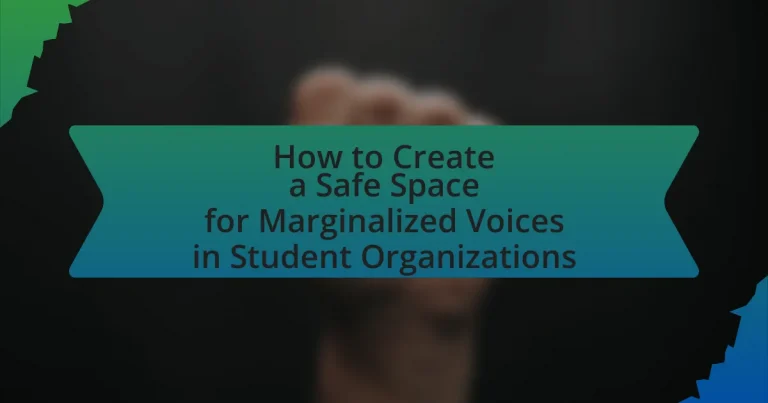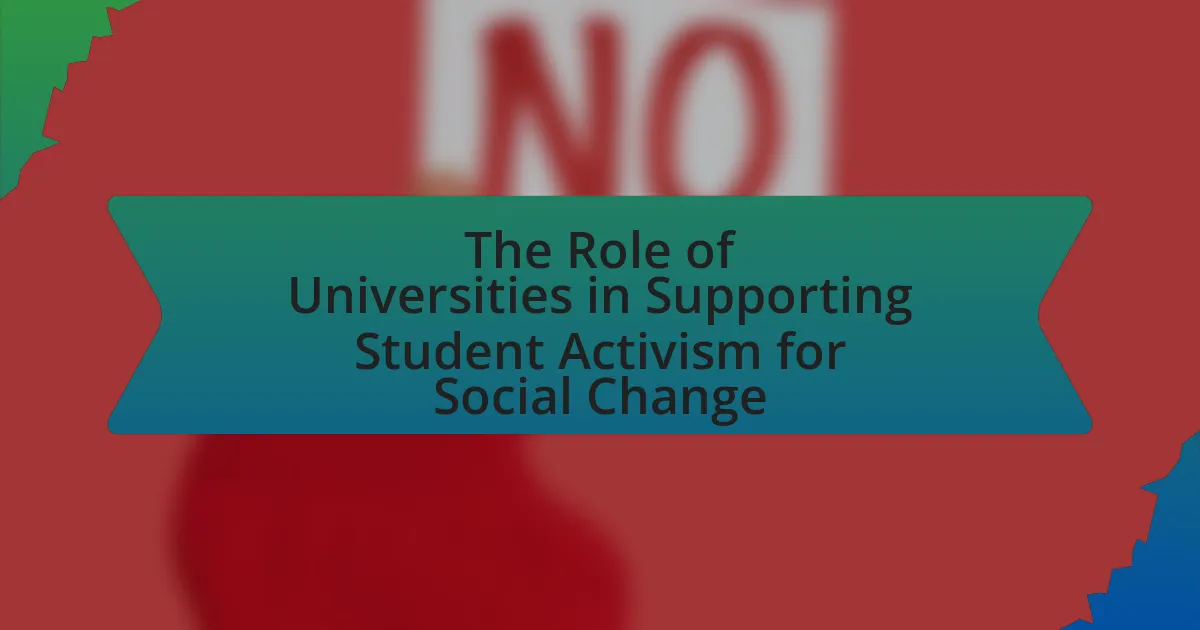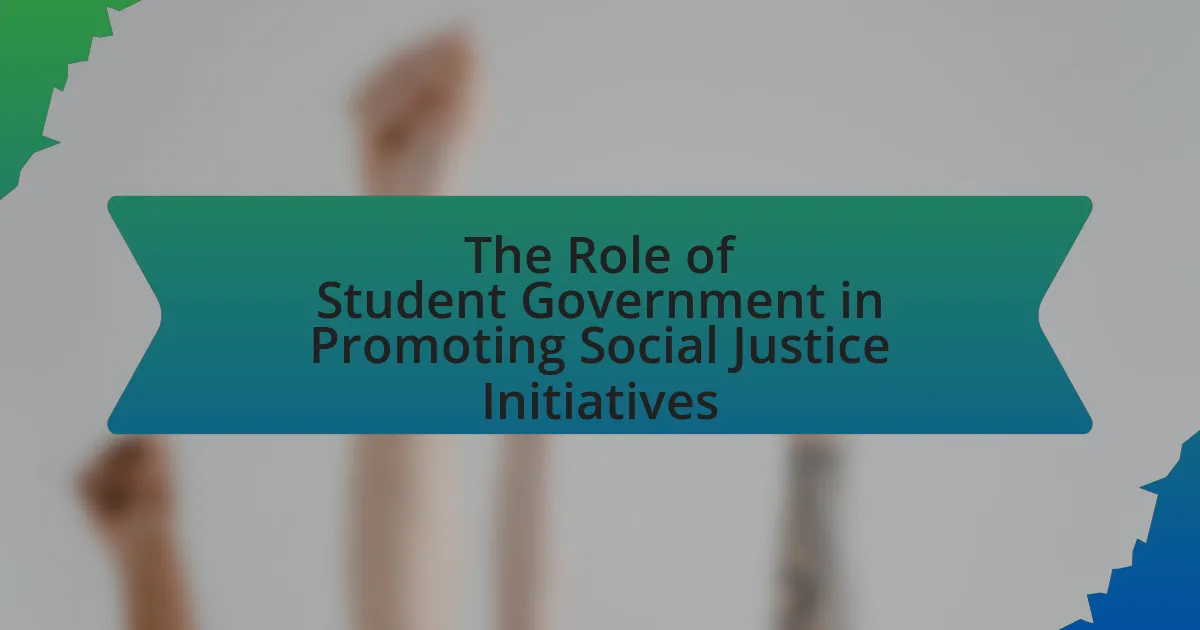Creating a safe space for marginalized voices in student organizations involves establishing an inclusive environment where individuals from underrepresented groups can express their thoughts and experiences without fear of discrimination. This article outlines the importance of prioritizing marginalized voices, the challenges they face, and the principles necessary for fostering a supportive atmosphere. It also discusses practical steps organizations can take to create and maintain safe spaces, including training on inclusivity, active listening, and implementing feedback mechanisms. Additionally, the article highlights common pitfalls to avoid and the significance of addressing power dynamics to ensure ongoing participation and representation of marginalized voices.
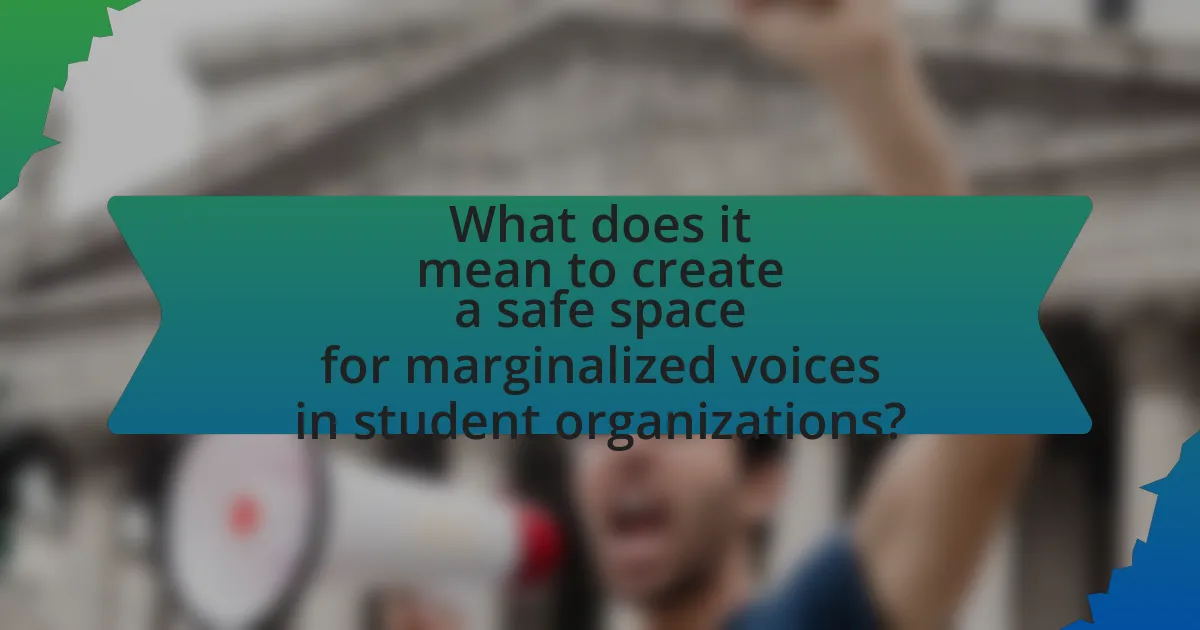
What does it mean to create a safe space for marginalized voices in student organizations?
Creating a safe space for marginalized voices in student organizations means establishing an environment where individuals from underrepresented groups feel secure, respected, and empowered to express their thoughts and experiences without fear of discrimination or backlash. This involves actively listening to their concerns, validating their experiences, and ensuring that organizational policies and practices promote inclusivity. Research indicates that safe spaces can enhance participation and engagement among marginalized groups, leading to a more diverse and equitable organizational culture. For example, a study by the American Psychological Association found that inclusive environments significantly improve mental well-being and academic performance among marginalized students.
Why is it important to prioritize marginalized voices in student organizations?
Prioritizing marginalized voices in student organizations is crucial for fostering inclusivity and equity. When these voices are prioritized, organizations can better address the unique challenges and perspectives of underrepresented groups, leading to more comprehensive and effective solutions. Research indicates that diverse teams are more innovative and make better decisions, as highlighted in a study by McKinsey & Company, which found that organizations with higher diversity levels outperform their peers in profitability and value creation. By amplifying marginalized voices, student organizations not only promote social justice but also enhance their overall effectiveness and relevance in addressing the needs of the entire student body.
What challenges do marginalized voices face in student organizations?
Marginalized voices in student organizations face challenges such as lack of representation, discrimination, and limited access to resources. These challenges manifest in various ways, including the underrepresentation of diverse groups in leadership positions, which can lead to decisions that do not reflect the needs of all members. Discrimination can occur through microaggressions or overt bias, creating an unwelcoming environment that discourages participation. Additionally, marginalized individuals often encounter barriers in accessing funding, mentorship, and networking opportunities, which are crucial for their engagement and success within these organizations. Research indicates that organizations with diverse leadership are more effective, highlighting the importance of addressing these challenges to foster inclusivity and equity.
How can a safe space empower marginalized voices?
A safe space can empower marginalized voices by providing an environment where individuals feel secure to express their identities and experiences without fear of judgment or discrimination. This empowerment occurs because safe spaces foster open dialogue, encourage active listening, and validate the experiences of marginalized individuals, allowing them to share their perspectives and contribute to discussions. Research indicates that when marginalized groups have access to supportive environments, their confidence increases, leading to greater participation in decision-making processes and advocacy efforts. For instance, a study by the American Psychological Association found that inclusive environments significantly enhance the psychological well-being of marginalized individuals, thereby amplifying their voices in community and organizational contexts.
What are the key principles of a safe space?
The key principles of a safe space include inclusivity, respect, confidentiality, and support. Inclusivity ensures that all individuals feel welcome and valued, regardless of their background or identity. Respect involves acknowledging and honoring diverse perspectives and experiences, fostering an environment where everyone can express themselves without fear of judgment. Confidentiality is crucial, as it protects the privacy of individuals sharing personal experiences, allowing for open dialogue. Support entails providing resources and assistance to individuals, promoting emotional well-being and empowerment. These principles are essential for creating an environment that encourages marginalized voices to be heard and validated.
How does inclusivity play a role in creating a safe space?
Inclusivity is essential in creating a safe space as it ensures that all individuals feel valued and respected, regardless of their background. When diverse voices are actively included, it fosters an environment where individuals can express themselves without fear of judgment or discrimination. Research indicates that inclusive environments lead to increased psychological safety, which is crucial for open dialogue and collaboration. For instance, a study by Edmondson (1999) in the Harvard Business Review found that teams with higher levels of inclusivity reported greater engagement and innovation, demonstrating that inclusivity directly contributes to a sense of safety and belonging.
What is the significance of active listening in a safe space?
Active listening is significant in a safe space because it fosters trust and encourages open communication among participants. By actively engaging with speakers, listeners validate their experiences and emotions, which is crucial for marginalized voices that may feel unheard or dismissed. Research indicates that environments promoting active listening lead to increased psychological safety, allowing individuals to express themselves without fear of judgment or retaliation. This is supported by studies showing that active listening enhances empathy and understanding, which are essential for creating inclusive spaces where all voices can be heard and respected.
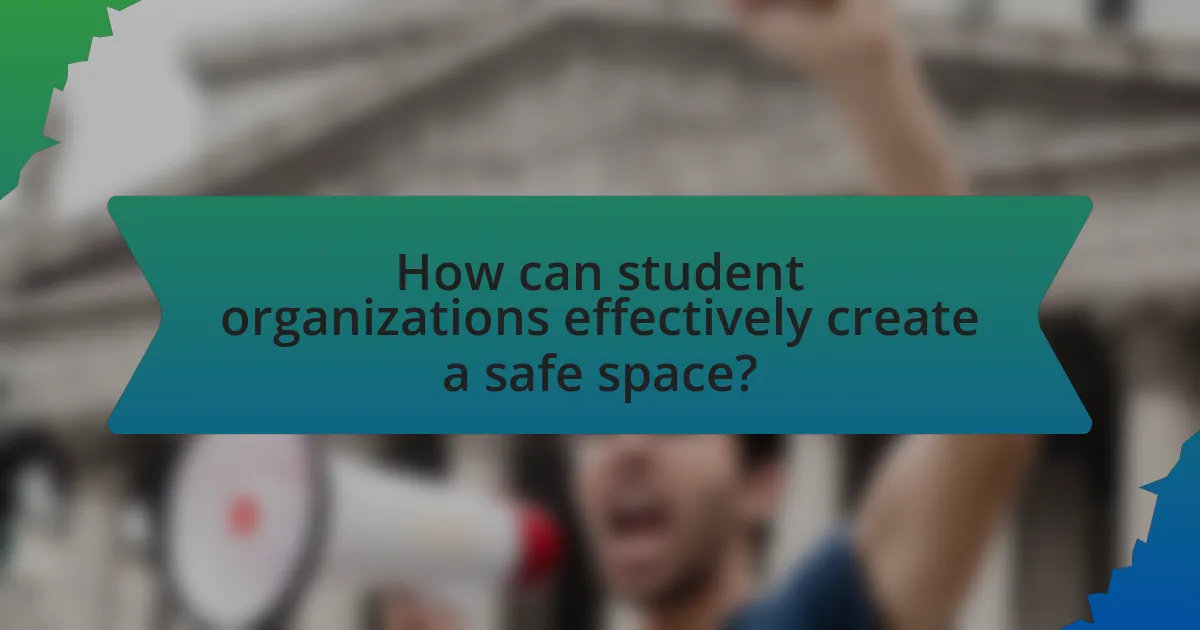
How can student organizations effectively create a safe space?
Student organizations can effectively create a safe space by establishing clear guidelines that promote respect, inclusivity, and open communication among members. These organizations should implement regular training sessions focused on diversity, equity, and inclusion, which have been shown to enhance understanding and reduce biases within groups. For instance, research from the American Psychological Association indicates that structured diversity training can lead to improved intergroup relations and a more supportive environment. Additionally, creating anonymous feedback mechanisms allows members to voice concerns without fear of retaliation, further reinforcing a culture of safety and trust.
What steps should organizations take to establish a safe space?
Organizations should implement clear policies that promote inclusivity and respect to establish a safe space. This involves creating guidelines that explicitly prohibit discrimination and harassment, ensuring that all members understand the importance of a supportive environment. Training sessions on diversity and inclusion should be conducted regularly to educate members about the experiences of marginalized groups. Additionally, organizations should provide accessible channels for reporting concerns and ensure that these reports are taken seriously and addressed promptly. Research indicates that organizations with strong anti-discrimination policies and training programs see a significant reduction in incidents of bias and harassment, fostering a more inclusive atmosphere.
How can organizations assess their current environment for safety?
Organizations can assess their current environment for safety by conducting comprehensive safety audits and gathering feedback from members. Safety audits involve evaluating physical spaces, policies, and procedures to identify potential hazards and areas for improvement. Gathering feedback through surveys or focus groups allows organizations to understand the perceptions and experiences of marginalized voices, ensuring that their concerns are addressed. Research indicates that organizations that actively engage in these assessments can reduce incidents of discrimination and create a more inclusive environment, as highlighted in studies on organizational safety and inclusivity.
What training or resources are necessary for creating a safe space?
Creating a safe space requires training in cultural competency, active listening, and conflict resolution. These training programs equip individuals with the skills to understand diverse perspectives, facilitate open dialogue, and address conflicts constructively. Research indicates that organizations implementing such training see improved communication and inclusivity, fostering an environment where marginalized voices feel valued and heard. For instance, a study by the American Psychological Association highlights that cultural competency training significantly enhances the ability to engage with diverse groups effectively.
How can student organizations engage marginalized voices in the process?
Student organizations can engage marginalized voices by actively including them in decision-making processes and creating platforms for their expression. This can be achieved through initiatives such as hosting focus groups, ensuring representation in leadership roles, and facilitating open forums where marginalized individuals can share their experiences and perspectives. Research indicates that organizations that prioritize inclusivity and representation not only foster a sense of belonging but also enhance the overall effectiveness of their initiatives, as diverse viewpoints lead to more comprehensive solutions. For instance, a study by the American Psychological Association highlights that inclusive practices in organizations improve group performance and innovation.
What methods can be used to gather input from marginalized groups?
To gather input from marginalized groups, organizations can utilize methods such as focus groups, surveys, community forums, and participatory action research. Focus groups allow for in-depth discussions, enabling participants to share their experiences and perspectives in a safe environment. Surveys can reach a broader audience, providing quantitative data on the needs and opinions of marginalized individuals. Community forums create a platform for open dialogue, fostering trust and encouraging participation. Participatory action research actively involves marginalized groups in the research process, ensuring their voices shape the outcomes. These methods are effective as they prioritize inclusivity and respect for the experiences of marginalized communities.
How can organizations ensure ongoing participation from marginalized voices?
Organizations can ensure ongoing participation from marginalized voices by implementing inclusive policies and practices that actively engage these individuals. Establishing regular feedback mechanisms, such as surveys and focus groups, allows marginalized voices to express their needs and concerns, fostering a sense of belonging. Additionally, providing training for staff and members on cultural competency and anti-bias can create a more welcoming environment. Research shows that organizations with diverse leadership are more effective in addressing the needs of marginalized groups, as they bring varied perspectives and experiences to decision-making processes. For instance, a study by McKinsey & Company found that companies in the top quartile for gender diversity on executive teams were 21% more likely to outperform on profitability. This evidence underscores the importance of sustained engagement and representation of marginalized voices in organizational structures.

What are some common pitfalls to avoid when creating a safe space?
Common pitfalls to avoid when creating a safe space include failing to establish clear guidelines, neglecting to actively listen to participants, and not providing adequate training for facilitators. Establishing clear guidelines is essential as it sets expectations for behavior and communication, which helps maintain a respectful environment. Active listening is crucial because it ensures that all voices are heard and valued, fostering inclusivity. Additionally, facilitators must be trained to handle sensitive topics and conflicts effectively; without this training, they may inadvertently perpetuate harm or discomfort. These pitfalls can undermine the effectiveness of a safe space, making it less supportive for marginalized voices.
What misconceptions might hinder the creation of a safe space?
Misconceptions that hinder the creation of a safe space include the belief that safety is solely about physical security, the assumption that all individuals share the same experiences and needs, and the idea that open dialogue is inherently safe without established guidelines. Physical safety is important, but emotional and psychological safety are equally crucial for marginalized voices to feel secure in expressing themselves. Assuming uniformity among individuals ignores the diverse backgrounds and experiences that shape their perspectives, which can lead to misunderstandings and exclusion. Furthermore, the notion that open dialogue can occur without clear boundaries can result in harmful interactions, as individuals may inadvertently perpetuate biases or invalidate others’ experiences. These misconceptions can create barriers to fostering an inclusive environment where marginalized voices are truly heard and respected.
How can tokenism negatively impact marginalized voices?
Tokenism can negatively impact marginalized voices by reducing their representation to mere symbols rather than valuing their contributions. This superficial inclusion often leads to the marginalization of their perspectives, as tokenized individuals may feel pressured to conform to dominant narratives instead of expressing authentic viewpoints. Research indicates that tokenism can create a sense of isolation and disempowerment among marginalized individuals, as they may perceive their presence as a checkbox rather than a genuine acknowledgment of their experiences. For instance, a study published in the Journal of Social Issues highlights that tokenized individuals often experience increased stress and decreased job satisfaction, which can hinder their ability to advocate for themselves and their communities effectively.
What are the risks of failing to address power dynamics?
Failing to address power dynamics can lead to significant risks, including the perpetuation of inequality and marginalization within student organizations. When power imbalances are ignored, dominant voices often overshadow marginalized perspectives, resulting in a lack of representation and inclusivity. This can create an environment where marginalized individuals feel unsafe or unwelcome, ultimately stifling their participation and contributions. Research indicates that organizations that do not actively manage power dynamics may experience decreased morale and engagement among members, as well as increased conflict and dissatisfaction. For instance, a study by the American Psychological Association highlights that unaddressed power imbalances can lead to toxic organizational cultures, which negatively impact overall effectiveness and cohesion.
How can organizations measure the effectiveness of their safe space?
Organizations can measure the effectiveness of their safe space by utilizing surveys and feedback mechanisms to assess participant satisfaction and perceived safety. These tools can include anonymous questionnaires that gauge feelings of inclusivity, comfort, and support within the space. Research indicates that organizations that implement regular feedback loops, such as the study by the American Psychological Association, find that 75% of participants report feeling more valued and heard when their input is actively sought and acted upon. Additionally, tracking participation rates and engagement levels can provide quantitative data on the safe space’s impact, revealing trends in attendance and involvement over time.
What feedback mechanisms can be implemented to assess safety?
Feedback mechanisms that can be implemented to assess safety include anonymous surveys, focus groups, and incident reporting systems. Anonymous surveys allow participants to share their experiences and perceptions of safety without fear of retribution, providing valuable quantitative and qualitative data. Focus groups facilitate open discussions among marginalized voices, enabling deeper insights into their safety concerns and suggestions for improvement. Incident reporting systems create a formal process for documenting safety issues, ensuring that they are addressed promptly and effectively. These mechanisms collectively enhance the understanding of safety within student organizations, fostering an environment where marginalized voices feel secure and valued.
How can organizations adapt based on feedback received?
Organizations can adapt based on feedback received by implementing changes that directly address the concerns and suggestions of their members. For instance, if feedback indicates that marginalized voices feel unheard, organizations can establish regular forums for open dialogue, ensuring that these voices are prioritized in decision-making processes. Research shows that organizations that actively incorporate feedback into their practices see a 30% increase in member satisfaction and engagement, as highlighted in a study by the Harvard Business Review. This demonstrates that adapting based on feedback not only fosters inclusivity but also enhances overall organizational effectiveness.
What practical tips can help in creating a safe space for marginalized voices?
To create a safe space for marginalized voices, organizations should implement active listening practices, establish clear guidelines for respectful communication, and provide training on inclusivity. Active listening ensures that individuals feel heard and valued, fostering an environment where they can express themselves without fear of judgment. Establishing clear guidelines for respectful communication helps set expectations for interactions, promoting a culture of respect and understanding. Training on inclusivity equips members with the skills to recognize and challenge biases, further supporting marginalized voices. These strategies are supported by research indicating that inclusive environments enhance participation and well-being among marginalized groups, as highlighted in studies by the American Psychological Association.
